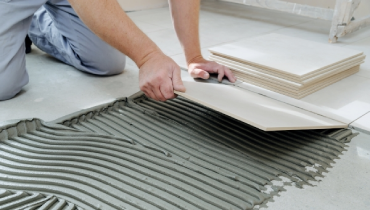
Mr. Handyman explains how to accurately calculate tiles needed for a floor shower.
|
You can see the result in your head: a newly tiled floor or a beautiful tile mosaic for your shower wall. But before ripping out the old material and installing new tile, you’ll have to answer the age-old question: How much tile do I need?
To help make this process easier we’ve organized a few different tile calculation formulas that should help you figure out how much tile you’ll need to get the job done.
How to Calculate Tiles Needed for a Floor
To calculate the number of tiles needed for any room’s floor, you’ll need to find the total area of the floor. This can get tricky if there are elements in the space that negate the need for tile.
Multiply the length of the room by the width of a room.
- 10 ft long x 10 ft wide = 100 ft2
To calculate your tile needs for an odd-shaped area, divide the space into squares or rectangles, calculate the area of those squares, and add them together. This is especially important if you’re trying to calculate the number of tiles needed for a bathroom that has a shower or tub. Here’s an example of adding two areas together to get the whole area:
- (3 ft long x 5 ft wide = 15 ft2 ) + (5 ft long x 9 ft wide = 45 ft2)
- 15 ft2 + 45 ft2 = 60 ft2
Now that you know how much area you need to cover, you can calculate exactly how many tiles you’ll need for your project. But don’t put that calculator away just yet!
First, measure the length and width of the individual tiles you’re planning to use for your floor.
Multiply a single tile’s length and width to determine how much area it covers.
- 6 in long x 6 in wide = 36 in2
Then divide that number by 144 to convert it to feet.
- 36 in2 / 144 = 0.25 ft2
Finally, divide the total square footage of the space by the single tile square footage.
- 60 ft2 / .25 ft2 = 240 tiles to cover the area of our odd-shaped room
Just remember: You don’t have to do this math alone—or the backbreaking work that follows—a local tile expert can help with the measurements and get the job done!
How Much Tile Do I Need for My Shower?
Just as you did for your floor math, divide your shower into multiple rectangles to add up the square footage of the surfaces. You can use a pencil and paper to keep track of the various dimensions. In most cases, you’ll need to account for three walls, plus the dimensions of any small niches or ledges.
Measure the length and width of each of your designated rectangles and multiply those measurements. Here’s an example:
-
Back wall: 6 ft x 6 ft = 36 ft2
-
Showerhead wall: 3 ft x 6 ft = 18 ft2
-
Side wall: 3 ft x 6 ft = 18 ft2
-
All walls combined: 36 ft2 + 18 ft2 + 18 ft2 = 72 ft2
If we plan on using the same 6-inch square tiles for this shower project, we’ll need to do just one more equation.
-
6 in x 6 in = 36 in2 per tile
-
36 / 144 = 0.25 ft2 per tile
-
72 ft2 / 0.25 ft2 = 288 tiles
Related Topic: How to Install Tile Over Existing Tile
How Much Extra Tile Do I Need?
We recommend ordering 10% to 20% more tile than your equation calls for. This will be handy for several reasons:
-
You may break or crack a tile while transporting or laying them.
-
You may need to cut tiles to fit neatly around corners.
-
You may need to replace a loose tile shortly after installation. (We all make mistakes!)
-
You may need to replace a tile that breaks in the future.
Tackle Your Next Tile Project with Confidence
The first step of a successful home improvement project is doing the planning, measuring, and material calculations correctly. The second step? It might be calling Mr. Handyman! Our professionals can repair, replace, or install tile in your home and take one item off your to-do list. Call or request service today.
This article is intended for general guidance only and is not applicable to every situation. You are responsible for determining the proper course of action for your property and situation. Mr. Handyman is not responsible for any damages that occur as a result of advice and/or guidance derived from its blog content. Some Mr. Handyman services vary by location. Contact your local Mr. Handyman franchise for more information.
FAQs About Calculating Floor Tiles
For over 25 years, Mr. Handyman professionals have been helping homeowners and businesses repair, maintain, and enhance their space. We are a one-stop solution for everything on your to-do list. This includes answering your questions about home repairs, maintenance, and improvements. Here are answers to some of your most frequently asked questions on how to calculate tiles needed for a floor, shower, or other home project.
How do I calculate how many tiles I need?
To calculate the tiles needed for your floor project, start by measuring the area’s length and width in feet. Multiply those numbers to get the total square footage. Then, divide that number by the square footage of a single tile. Always round up and add 10% extra for cuts, mistakes, and spares—more if you're working with angled layouts or tricky spaces.
What is the floor tiles calculation formula?
The floor tiles calculation formula is simple and helps ensure you're buying the right amount the first time. Here's how it works:
Floor Area (sq. ft) ÷ Tile Area (sq. ft) = Number of Tiles Needed
Once you have the number of tiles needed, add 10–15% to cover cuts, waste, or future replacements. This formula works whether you're tiling a bathroom floor, hallway, or full kitchen.
How much tile do I need for my shower?
To calculate tile needs for your shower, start by measuring the height and width of each wall (including alcoves and built-in shelves). Multiply height × width to get the square footage for each surface. Add all totals together (include the floor area if you’re tiling that too). As with any tiling project, increase your total by at least 10% to account for mistakes and irregular cuts.
Mr. Handyman Tip: Shower tiling requires special considerations like waterproofing and tile layout, so if you’re unsure, it’s smart to consult a professional.
How do I account for tile spacing (grout lines) in my calculation?
Grout lines might seem small, but they impact your final tile count. If you’re using a larger grout line (⅛ inch or more), you may need slightly fewer tiles overall. Most online floor tile calculators will account for this automatically. However, if you’re measuring manually, assume that grout spacing is already factored into tile size (especially with mosaics or pre-spaced sheets).
When in doubt, round up and include 10–15% overage in your tile order to cover spacing variations and potential miscuts.
Can I use the same method for walls and floors?
Yes! Whether you're tiling a wall, floor, or ceiling, the core method for how to calculate the tiles needed stays the same: Measure the area, calculate the square footage, divide by the tile size, and round up. That said, walls often involve more obstacles like windows, outlets, or trim, which means more cuts, so never forget to add an overage buffer.
For complex layouts or custom tile shapes, especially in shower installations, it’s smart to confirm your math with a tile professional, especially if you’re unsure how much tile you need for your shower or which floor tiles calculation formula to trust.
What happens if I buy too few tiles?
Coming up short is a common mistake—and it can be a costly one. You might:
- Delay your project waiting for matching tiles to come back in stock
- End up with different dye lots, causing slight color variations
- Pay more in labor if installers have to return for a second trip
That’s why using a trusted floor tile calculation formula and ordering enough the first time (with a buffer) is key to a smooth installation.
Should I install tiles myself or hire a professional?
Measuring is one thing—installation is another. DIY tiling can be tricky, especially when waterproofing, spacing, and tile layout come into play. Uneven surfaces, tile breakage, and grout issues can all affect the final result.
Whether you’re planning a bathroom remodel, calculating backsplash dimensions, or simply wondering, “How much tile do I need for my shower?”, Mr. Handyman is here to help. Skip the stress and trust a pro for expert installation. Find your local Mr. Handyman today.
